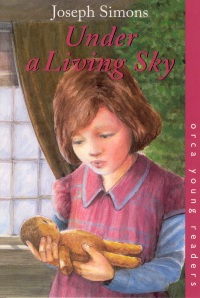| ________________
CM . . .
. Volume XII Number 10 . . . .January 20, 2006
excerpt:
The novel's setting is a Saskatchewan farm in the midst of the Depression. It can be assumed that the novel opens in late 1936 as near the end of the story the crop outlook for 1937 is given. The main characters are two sisters, Mary and Judith. Their ages are never stated, but since Judith was born the year before the crash of 1929, she would be coming nine and Mary, who is one year younger, would be coming eight. As the novel begins, Mary and her sister Judith are at odds. Judith's resentment of Mary is obvious. She pinches and kicks Mary usually in their shared bed away from parental eyes, and she often tries to get Mary in difficulty with their parents. In turn, Mary revels in her father's love and concern for her, which is in contrast to his seeming cold-shouldered relationship with Judith. Mary has not yet started school because of a hole in her heart, but she is to begin the next school year. At Christmas, Mary's dream of receiving new shoes to replace her cracked, hand-me-down shoes from Judith is shattered. Judith gets "new" second-hand shoes, and Mary receives an oat-stuffed doll made from one of their horse's old canvas nosebags. The doll is in sharp contrast to Judith's fancy china-faced doll, received in better financial times. Mary is devastated. However, over the next weeks and months, Mary and her doll, Jessy, become inseparable. Then Jessy mysteriously disappears. Judith's attitude towards Mary begins to change dramatically. She hunts the farm with Mary looking for the doll. Judith comforts Mary when she weeps over Jessy's disappearance. The two sisters become best friends and spend all their time together when Judith isn't in school. An early spring discloses an unthinkable secret. Judith had buried Jessy during a winter Chinook and now the oats in Jessy have sprouted in the shape of the doll's body, forming a star. Judith spills out her story—Mary had everything—her parents loved Mary more and then Mary had a beloved doll. She apologizes to Mary. Mary's character has also grown over the course of the novel, and she knows that, if she stays angry with Judith, their friendship will be destroyed. She chooses to forgive and, in turn, apologizes to Judith as she realizes how smug she had been about having her parents' attention, especially that of her father. Although readers usually "read up," this book does not seem suitable for students who are seven and eight because of topics touched on such as the Depression causing men to commit suicide, infant mortality, the spending of money on medication for the mother creating further financial hardships, the tension between the parents, the father's seeming loss of faith, references to Hitler and the possibility of war approaching, and the radio broadcast about General Motors and the acceptance of the Auto Workers Union with reference to the National Guard's machine gun nests during the protest in Flint, Michigan. The book does provide an authentic look at the effects of the Depression on a prairie farm family in Saskatchewan, and for this reason it is a useful novel for teaching about this period in Canadian history. Vocabulary, such as cutter, prairie dog town, nosebag, root cellar, the Depression, wireless, mire, and so on, will need to be taught if the readers/students are to fully appreciate the time and place of the novel. Because the main characters are girls, boys may not be as interested in the story. There is a young brother, but he is a minor character. A multi-discipline teacher's guide is available on line from Orca. Recommended. Jeannette Timmerman is a former teacher and principal with the Winnipeg (MB) School Division.
To comment
on this title or this review, send mail to cm@umanitoba.ca.
Copyright © the Manitoba Library Association. Reproduction for personal
use is permitted only if this copyright notice is maintained. Any
other reproduction is prohibited without permission.
NEXT REVIEW |
TABLE OF CONTENTS FOR THIS ISSUE
- January 20, 2006.
AUTHORS |
TITLES |
MEDIA REVIEWS |
PROFILES |
BACK ISSUES |
SEARCH |
CMARCHIVE |
HOME |
